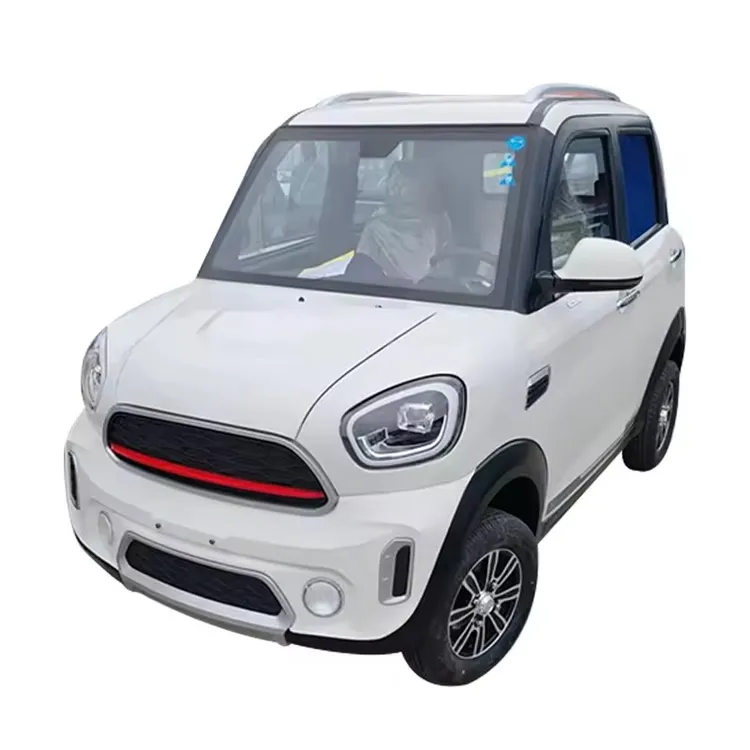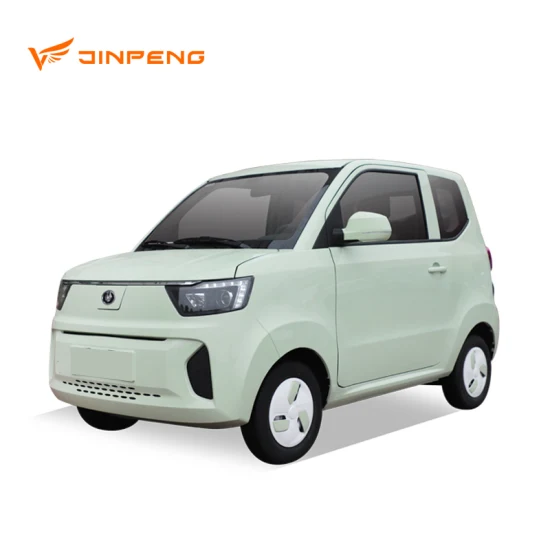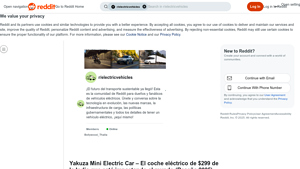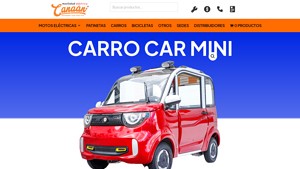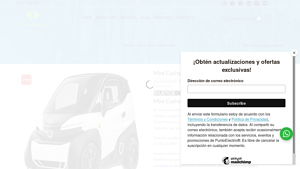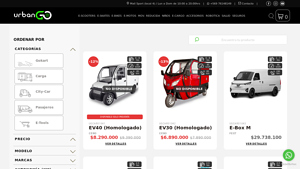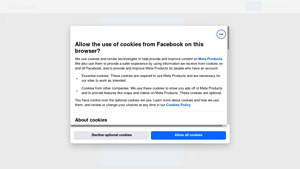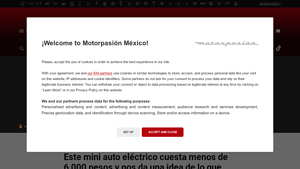Introduction: Navigating the Global Market for mini auto electrico
In the rapidly evolving landscape of urban mobility, sourcing the right mini auto electrico presents a unique challenge for international B2B buyers. As cities around the globe strive to reduce their carbon footprint, the demand for compact, electric vehicles tailored for urban environments is surging. This guide offers a comprehensive overview of the mini auto electrico market, focusing on essential aspects such as types of vehicles available, their applications in various sectors, and effective strategies for supplier vetting.
International buyers, particularly from regions like Africa, South America, the Middle East, and Europe, will find valuable insights on how to navigate the complexities of sourcing these vehicles. We delve into cost considerations, charging infrastructure, and the regulatory landscape that influences purchasing decisions. By providing a detailed analysis of market trends and supplier capabilities, this guide empowers businesses to make informed decisions that align with their sustainability goals and operational needs.
Whether you are looking to enhance your fleet with eco-friendly options or seeking innovative transportation solutions for urban logistics, understanding the intricacies of the mini auto electrico market is crucial. Equip yourself with the knowledge to capitalize on this growing trend and contribute to a greener future.
Understanding mini auto electrico Types and Variations
| Type Name | Key Distinguishing Features | Primary B2B Applications | Brief Pros & Cons for Buyers |
|---|---|---|---|
| Urban Electric Vehicle | Compact size, low speed (up to 45 km/h), ideal for city use | Urban deliveries, short-distance transport | Pros: Low operational costs, eco-friendly; Cons: Limited speed and range. |
| Mini Electric Car | Higher speed capabilities (up to 85 km/h), more spacious | Ride-sharing, personal use | Pros: Versatile for urban and suburban areas; Cons: Higher purchase price. |
| Light Electric Vehicle | Lightweight, often designed for single-passenger use | Last-mile delivery, tourism | Pros: Extremely low energy costs; Cons: Limited capacity and comfort. |
| Electric Trikes | Three-wheeled design, stability, and cargo capacity | Logistics, food delivery | Pros: Better stability and load capacity; Cons: Less maneuverable than cars. |
| Luxury Mini EV | Premium features, high-quality materials, advanced tech | Corporate fleets, luxury rentals | Pros: Attractive branding and comfort; Cons: Higher initial investment. |
What Are the Key Characteristics of Urban Electric Vehicles?
Urban Electric Vehicles (UEVs) are specifically designed for city environments, characterized by their compact size and limited speed, typically capping at 45 km/h. They offer significant savings on fuel and maintenance due to their electric nature, making them ideal for businesses focusing on urban deliveries or short-distance transport. B2B buyers should consider the operational cost advantages, though the limited speed and range may restrict their use in broader applications.
How Do Mini Electric Cars Serve B2B Needs?
Mini Electric Cars provide a balance of speed and space, reaching speeds of up to 85 km/h. Their larger size accommodates more passengers or cargo, making them suitable for ride-sharing services or personal use within corporate fleets. When purchasing, businesses should weigh the initial investment against the versatility and potential for higher revenue generation in urban and suburban markets.
What Makes Light Electric Vehicles Suitable for Specific Applications?
Light Electric Vehicles are designed for efficiency, often accommodating a single passenger and emphasizing lightweight construction. They are particularly effective for last-mile delivery services and tourism, where low operational costs are paramount. However, B2B buyers must consider the limitations regarding passenger capacity and comfort, which may not suit all business models.
Why Choose Electric Trikes for Logistics and Delivery?
Electric Trikes offer a unique three-wheeled design that provides enhanced stability and increased cargo capacity. They are particularly valuable in logistics and food delivery sectors, where maneuverability and load-bearing capabilities are critical. While they provide excellent stability, B2B buyers should assess their suitability against the need for compactness in urban environments.
What Advantages Do Luxury Mini EVs Offer Corporate Fleets?
Luxury Mini Electric Vehicles combine premium features with advanced technology, appealing to businesses that prioritize branding and comfort in their fleets. They are particularly suited for corporate rentals or high-end transportation services. However, the higher initial investment may be a deterrent for some buyers, necessitating a thorough cost-benefit analysis.
Key Industrial Applications of mini auto electrico
| Industry/Sector | Specific Application of mini auto electrico | Value/Benefit for the Business | Key Sourcing Considerations for this Application |
|---|---|---|---|
| Urban Mobility Services | Shared electric vehicle fleets | Reduces operational costs and enhances sustainability | Charging infrastructure availability and maintenance support |
| Logistics and Delivery | Last-mile delivery solutions | Lowers carbon footprint and operational expenses | Battery life and vehicle range for varied urban environments |
| Tourism and Hospitality | Eco-friendly transport for guests | Enhances brand image and customer experience | Vehicle comfort, safety features, and local regulations |
| Municipal Services | City maintenance and surveillance vehicles | Cost-effective and eco-friendly urban management | Compliance with local environmental policies and regulations |
| Retail and Commercial | Employee shuttles and customer transport | Increases employee satisfaction and reduces costs | Fleet management software and charging station accessibility |
How Are Mini Auto Electricos Transforming Urban Mobility Services?
In urban mobility services, mini auto electrico vehicles are increasingly being utilized in shared vehicle fleets. These electric vehicles are advantageous for companies aiming to reduce operational costs associated with fuel and maintenance. Additionally, they contribute to sustainability initiatives by lowering emissions. For international buyers, considerations such as the availability of charging infrastructure and ongoing maintenance support are crucial for ensuring efficient fleet operation.
What Role Do Mini Auto Electricos Play in Logistics and Delivery?
In the logistics sector, mini auto electrico vehicles are ideal for last-mile delivery solutions. Their compact size allows for easier navigation through congested urban areas, while their electric nature significantly reduces carbon emissions. Businesses benefit from lower operational expenses linked to fuel and maintenance. Buyers should assess battery life and vehicle range to ensure these vehicles can meet the demands of their specific urban environments.
How Can Tourism and Hospitality Leverage Mini Auto Electricos?
The tourism and hospitality industry can utilize mini auto electrico vehicles to provide eco-friendly transportation options for guests. This not only enhances the customer experience but also aligns with the growing trend of sustainability in travel. Businesses can improve their brand image by promoting their commitment to environmental responsibility. When sourcing these vehicles, factors such as comfort, safety features, and compliance with local regulations must be carefully evaluated.
Why Are Mini Auto Electricos Essential for Municipal Services?
Municipal services can greatly benefit from the integration of mini auto electrico vehicles for maintenance and surveillance tasks. These vehicles offer a cost-effective solution while promoting eco-friendly practices within urban management. They help cities reduce their overall carbon footprint and adhere to environmental policies. Buyers should focus on compliance with local regulations and the vehicle’s ability to meet specific operational requirements for municipal tasks.
How Do Mini Auto Electricos Enhance Retail and Commercial Operations?
In the retail sector, mini auto electrico vehicles can be used for employee shuttles and customer transport services. They not only increase employee satisfaction by providing convenient transportation but also reduce operational costs associated with traditional fuel vehicles. For businesses looking to invest in these vehicles, it’s vital to consider fleet management software capabilities and the accessibility of charging stations to ensure seamless operations.
3 Common User Pain Points for ‘mini auto electrico’ & Their Solutions
Scenario 1: Navigating the Initial Investment in Mini Electric Vehicles
The Problem: For many B2B buyers, the upfront cost of acquiring mini electric vehicles (mini auto electrico) can be daunting. Companies in emerging markets like Brazil, Nigeria, and other regions may face budget constraints, making it challenging to justify the expense despite the long-term savings on fuel and maintenance. Additionally, potential buyers might be unfamiliar with the various financing options available, further complicating their decision-making process.
The Solution: To alleviate the financial burden, businesses should explore various financing options tailored for electric vehicles. This could include government incentives, grants, or low-interest loans specifically designed for sustainable transport solutions. Engaging with local financial institutions that have experience in green financing can provide insights into affordable leasing options or partnerships with manufacturers offering flexible payment plans. Furthermore, prospective buyers should conduct a total cost of ownership analysis, considering long-term savings on fuel, maintenance, and tax incentives, to present a compelling business case to stakeholders. Leveraging case studies from similar businesses in their region can also help demonstrate the viability and benefits of transitioning to mini electric vehicles.
Scenario 2: Addressing Charging Infrastructure Limitations
The Problem: A significant challenge for B2B buyers is the lack of adequate charging infrastructure, particularly in regions where mini auto electrico are being introduced. Without accessible charging stations, companies may struggle to maintain operational efficiency, leading to concerns about vehicle downtime and employee productivity. This issue is particularly pronounced in countries like Nigeria and Brazil, where urban infrastructure may still be developing.
The Solution: To overcome this hurdle, businesses should invest in the installation of private charging stations at their facilities. Collaborating with local governments and energy providers to identify suitable locations for public charging stations can also foster community-wide solutions. Companies can take advantage of available incentives for installing charging infrastructure, which can reduce initial costs. Additionally, B2B buyers should consider investing in portable charging solutions that can provide flexibility and convenience for their fleet. By engaging with manufacturers that offer comprehensive support for infrastructure development, businesses can ensure they have the necessary resources in place to operate their mini electric vehicles efficiently.
Scenario 3: Understanding Battery Life and Maintenance Needs
The Problem: Many B2B buyers are concerned about the longevity and maintenance requirements of the batteries used in mini auto electrico. Misunderstandings about battery performance, including charging cycles and lifespan, can lead to apprehension regarding their reliability and overall investment. Companies may fear unexpected costs related to battery replacements or maintenance, especially in regions where support services may be limited.
The Solution: To mitigate these concerns, it is essential for buyers to thoroughly research the specifications and warranties associated with the batteries of their chosen mini electric vehicles. Engaging with manufacturers that provide transparent information about battery life, cycle counts, and maintenance requirements will empower buyers to make informed decisions. Additionally, companies should consider establishing a regular maintenance schedule and training staff on basic battery care to maximize longevity and performance. Furthermore, exploring battery leasing options can reduce the burden of unexpected replacement costs, allowing businesses to manage expenses more effectively. By prioritizing education on battery technology and maintenance, buyers can ensure a smoother transition to electric mobility and a more sustainable operation.
Strategic Material Selection Guide for mini auto electrico
What Are the Key Materials Used in Mini Electric Cars?
The selection of materials for mini electric cars is crucial as it directly influences performance, safety, and cost-efficiency. Below are analyses of four common materials used in the construction of mini electric vehicles, focusing on their properties, advantages, disadvantages, and considerations for international B2B buyers.
How Does Aluminum Benefit Mini Electric Cars?
Key Properties: Aluminum is lightweight, with excellent corrosion resistance and good thermal conductivity. It can withstand a wide range of temperatures, making it suitable for various climates.
Pros & Cons: The primary advantage of aluminum is its low weight, which contributes to improved energy efficiency and range. However, it can be more expensive than other materials and may require specialized manufacturing processes, which can increase overall production costs.
Impact on Application: Aluminum is commonly used in the chassis and body panels of mini electric cars, enhancing structural integrity while minimizing weight. This is particularly important for electric vehicles where battery weight is a significant factor.
Considerations for International Buyers: Buyers from regions such as Africa and South America should consider local availability and recycling practices, as aluminum can be more sustainable when sourced locally. Compliance with international standards like ASTM or DIN for aluminum alloys is also essential.
What Role Does High-Strength Steel Play in Mini Electric Cars?
Key Properties: High-strength steel offers excellent tensile strength and durability, making it ideal for safety-critical components.
Pros & Cons: While high-strength steel is cost-effective and provides robust crash protection, it is heavier than alternatives like aluminum. This weight can negatively impact the vehicle’s range and efficiency.
Impact on Application: This material is often used in the frame and safety structures of mini electric cars, ensuring passenger safety during collisions.
Considerations for International Buyers: Buyers should ensure that the steel used meets local safety standards and regulations. Different regions may have varying preferences for steel grades, impacting sourcing decisions.
How Do Composite Materials Enhance Mini Electric Cars?
Key Properties: Composites, such as carbon fiber and fiberglass, are lightweight and possess high strength-to-weight ratios. They also offer excellent corrosion resistance.
Pros & Cons: Composites can significantly reduce weight, enhancing vehicle performance. However, they are generally more expensive and can complicate manufacturing processes due to the need for specialized techniques.
Impact on Application: Composites are often used in body panels and interior components, providing aesthetic appeal while maintaining performance.
Considerations for International Buyers: Buyers should be aware of the certification requirements for composite materials in their respective regions. Understanding the lifecycle and recyclability of composites is also crucial for sustainable practices.
What Advantages Do Lithium-Ion Batteries Provide for Mini Electric Cars?
Key Properties: Lithium-ion batteries have high energy density, low self-discharge rates, and a long cycle life, making them ideal for electric vehicles.
Pros & Cons: These batteries are lightweight and can be charged quickly, providing significant advantages in range and efficiency. However, they can be costly and require careful management to ensure safety and longevity.
Impact on Application: Lithium-ion batteries are the primary energy source for mini electric cars, directly impacting range and performance.
Considerations for International Buyers: Buyers must consider regional regulations regarding battery disposal and recycling. Compliance with international standards for battery safety and performance is also essential, especially in markets with stringent environmental laws.
Summary Table of Material Selection for Mini Electric Cars
| Material | Typical Use Case for mini auto electrico | Key Advantage | Key Disadvantage/Limitation | Relative Cost (Low/Med/High) |
|---|---|---|---|---|
| Aluminum | Chassis and body panels | Lightweight, enhances efficiency | Higher cost, specialized manufacturing | High |
| High-Strength Steel | Frame and safety structures | Excellent durability and safety | Heavier, impacts range | Medium |
| Composite Materials | Body panels and interiors | High strength-to-weight ratio | Expensive, complex manufacturing | High |
| Lithium-Ion Batteries | Energy source for electric propulsion | High energy density, fast charging | Costly, requires careful management | High |
This strategic material selection guide provides valuable insights for international B2B buyers, enabling them to make informed decisions while considering the unique demands of their respective markets.
In-depth Look: Manufacturing Processes and Quality Assurance for mini auto electrico
What Are the Main Stages in the Manufacturing Process of Mini Auto Electrico?
The manufacturing process of mini auto electrico involves several critical stages that ensure the production of high-quality electric vehicles. Understanding these stages can help B2B buyers in Africa, South America, the Middle East, and Europe assess potential suppliers effectively.
Material Preparation: How Are Components Sourced and Prepared?
The first step in the manufacturing process is material preparation, which involves sourcing high-quality materials like lightweight metals (aluminum), plastics, and advanced batteries. Suppliers often focus on sustainable sourcing to align with the environmentally friendly ethos of electric vehicles. For instance, lithium-ion batteries are typically sourced from reputable manufacturers with a proven track record in safety and performance.
During this stage, materials undergo rigorous quality checks to ensure they meet international standards. Buyers should verify that suppliers adhere to certifications like ISO 9001, which emphasizes quality management systems, ensuring consistent product quality.
Forming: What Techniques Are Used to Shape the Vehicle Components?
Once the materials are ready, the next phase is forming. This includes processes such as stamping, molding, and machining to create the various parts of the vehicle. For mini auto electrico, advanced techniques like CNC machining and injection molding are commonly employed to achieve precision and efficiency.
Using lightweight materials is crucial in this stage, as it contributes to the overall energy efficiency of the vehicle. B2B buyers should inquire about the technologies utilized during this phase, as advanced forming techniques can significantly impact the vehicle’s performance.
Assembly: How Are the Components Joined Together?
The assembly stage involves integrating all the formed components into a complete vehicle. This process typically includes the installation of the electric motor, battery pack, wiring, and control systems. Automation plays a significant role here, with robotic systems used for tasks such as welding and painting to enhance accuracy and speed.
Quality control checkpoints are essential during assembly. Buyers should look for suppliers that implement In-Process Quality Control (IPQC) measures, ensuring that each stage of assembly meets predefined standards. This reduces the risk of defects and enhances the overall reliability of the finished product.
Finishing: What Steps Are Taken to Ensure a High-Quality Finish?
After assembly, the finishing stage focuses on aesthetics and functionality. This includes painting, application of protective coatings, and installation of interior features. Attention to detail during this stage is critical, as it not only affects the vehicle’s appearance but also its longevity and performance.
Suppliers often conduct Final Quality Control (FQC) checks to ensure that the finished vehicle meets all specifications and standards. Buyers can request information on the finishing processes to ensure that suppliers are committed to delivering top-quality products.
What International Standards and Quality Assurance Practices Are Relevant?
Quality assurance is paramount in the manufacturing of mini auto electrico, especially for international buyers who require adherence to specific standards.
Which International Standards Should B2B Buyers Look For?
Key international standards such as ISO 9001 for quality management and ISO 14001 for environmental management are crucial indicators of a supplier’s commitment to quality. Additionally, compliance with CE marking for products sold in Europe ensures that the vehicles meet safety and environmental requirements.
For buyers in regions such as Africa and South America, understanding local certifications and regulations is also essential. Suppliers should be familiar with the regulatory landscape in their target markets to avoid compliance issues.
What Quality Control Checkpoints Are Essential in the Manufacturing Process?
Quality control checkpoints are integral to maintaining product integrity throughout the manufacturing process. The following are common checkpoints that B2B buyers should be aware of:
- Incoming Quality Control (IQC): This phase involves inspecting raw materials and components upon arrival to ensure they meet specified standards before production begins.
- In-Process Quality Control (IPQC): Continuous checks during the manufacturing process help identify and rectify any issues immediately.
- Final Quality Control (FQC): A comprehensive inspection of the finished vehicle to ensure it meets all specifications and quality standards.
What Testing Methods Are Commonly Used in the Quality Assurance of Mini Auto Electrico?
Various testing methods are employed to validate the safety and performance of mini auto electrico. These include:
- Electrical Testing: To assess battery performance, charging efficiency, and overall electrical system integrity.
- Durability Testing: Simulating real-world conditions to evaluate the vehicle’s performance under various scenarios.
- Safety Testing: Includes crash tests and safety feature assessments to ensure compliance with safety regulations.
B2B buyers should request documentation of testing procedures and results from suppliers to ensure transparency and reliability.
How Can B2B Buyers Verify Supplier Quality Control Practices?
Verification of supplier quality control practices is crucial for B2B buyers to mitigate risks and ensure product quality.
What Audit Processes Should Buyers Implement?
Buyers should conduct regular audits of potential suppliers to assess their manufacturing processes and quality control measures. This can include both on-site visits and reviews of quality management systems. Questions to consider during audits include:
- What certifications does the supplier hold?
- What quality control measures are implemented at each stage of production?
- How does the supplier handle non-conformities and product recalls?
Are Third-Party Inspections Beneficial?
Engaging third-party inspection services can provide an unbiased assessment of a supplier’s quality control processes. These inspections can cover various aspects, from material quality to final product performance. Buyers should consider investing in such services, especially for large orders or new suppliers.
What Are the Quality Control Nuances for International Buyers?
International buyers must navigate various quality control nuances, particularly when sourcing mini auto electrico from different regions. Understanding local regulations, standards, and cultural practices is essential.
How Do Cultural Differences Impact Quality Assurance?
Cultural attitudes towards quality and compliance can vary significantly across regions. Buyers should be aware of these differences and establish clear communication channels with suppliers to ensure mutual understanding of quality expectations.
What Regulatory Compliance Should Buyers Be Aware Of?
Different countries have varying regulations regarding electric vehicles, including safety, emissions, and manufacturing practices. Buyers should familiarize themselves with these regulations in their target markets to ensure compliance and avoid potential issues.
By understanding these manufacturing processes and quality assurance practices, B2B buyers can make informed decisions when sourcing mini auto electrico, ensuring they partner with reliable suppliers that meet their quality standards.
Practical Sourcing Guide: A Step-by-Step Checklist for ‘mini auto electrico’
This guide serves as a practical checklist for B2B buyers aiming to procure mini electric vehicles (mini auto eléctrico). With the rise of urban mobility solutions, understanding the sourcing process is crucial to ensure you select the right vehicle that meets your operational needs while adhering to regulatory and sustainability standards.
Step 1: Define Your Technical Specifications
Establishing clear technical specifications is vital before reaching out to suppliers. Consider factors such as battery capacity, range, speed, and passenger capacity. These specifications will guide your discussions with potential suppliers and ensure that the vehicles align with your operational requirements.
Step 2: Identify Regulatory Compliance Requirements
Different regions have varying regulations regarding electric vehicles. Research local standards, including safety, emissions, and tax incentives for electric cars. Understanding these regulations will help you avoid compliance issues and maximize potential financial benefits, such as tax exemptions or rebates.
Step 3: Evaluate Potential Suppliers
Before committing, it’s crucial to vet suppliers thoroughly. Request company profiles, case studies, and references from buyers in a similar industry or region. Look for suppliers with a proven track record of quality and reliability in the electric vehicle market, as well as after-sales support.
- Check for Certifications: Ensure that suppliers have the necessary certifications for electric vehicles, such as ISO or local standards.
- Assess Production Capacity: Confirm that the supplier can meet your demand volume within your required timeframe.
Step 4: Analyze Total Cost of Ownership (TCO)
Understanding the total cost of ownership is essential in making a financially sound decision. This includes not only the purchase price but also maintenance costs, charging infrastructure, insurance, and potential tax benefits.
- Consider Maintenance Requirements: Evaluate the expected maintenance and repair costs over the vehicle’s lifecycle.
- Charging Infrastructure Costs: Factor in the expenses associated with installing and maintaining charging stations.
Step 5: Request Test Drives and Demonstrations
Before finalizing your decision, arrange for test drives or product demonstrations. This hands-on experience will allow you to assess the vehicle’s performance, comfort, and suitability for your operational needs.
- Evaluate User Experience: Pay attention to ease of use, technology integration, and overall driving comfort.
- Seek Feedback from Drivers: Gather input from your team who will be using the vehicles to ensure they meet practical requirements.
Step 6: Negotiate Terms and Conditions
Once you have selected a potential supplier, it’s time to negotiate the terms of purchase. Discuss payment terms, warranty options, and after-sales support. Ensuring favorable terms can enhance your operational efficiency and provide peace of mind.
- Warranty and Support Services: Inquire about the warranty coverage and the availability of spare parts.
- Payment Flexibility: Look for options that allow for financing or payment plans that suit your budget.
Step 7: Finalize the Purchase and Plan for Integration
After agreeing on terms, finalize the purchase and develop a plan for integrating the vehicles into your operations. This includes training for your drivers, setting up charging infrastructure, and scheduling regular maintenance checks.
- Training Programs: Ensure that your staff is adequately trained on vehicle operation and maintenance protocols.
- Monitor Performance: Establish metrics to track the performance and efficiency of the vehicles post-integration.
By following these steps, B2B buyers can navigate the procurement process for mini electric vehicles more effectively, ensuring they make informed decisions that align with their business objectives and sustainability goals.
Comprehensive Cost and Pricing Analysis for mini auto electrico Sourcing
What Are the Key Cost Components in Sourcing Mini Auto Electrico?
When considering the procurement of mini electric vehicles, understanding the cost structure is essential. The primary cost components include:
-
Materials: The selection of high-quality materials is crucial for durability and performance. Key materials include lightweight metals for the chassis, lithium batteries for power, and advanced plastics for bodywork. Prices for these materials can fluctuate based on global supply chains, impacting overall costs.
-
Labor: Labor costs can vary significantly by region. In countries with lower labor costs, such as parts of Africa and South America, manufacturers may achieve a lower cost base. However, it’s essential to ensure that labor is skilled enough to maintain quality standards.
-
Manufacturing Overhead: This includes expenses related to factory operation, utilities, and administrative costs. Efficient manufacturing processes can help reduce overhead costs, making it vital to assess potential suppliers’ operational efficiencies.
-
Tooling: Initial tooling costs can be substantial, particularly for custom designs. Buyers should inquire about the tooling costs associated with specific modifications or features, as these can significantly influence the total price.
-
Quality Control (QC): Implementing rigorous QC measures is essential for ensuring vehicle safety and reliability. While this can add to costs, it is a necessary investment to avoid long-term expenses related to warranty claims or product recalls.
-
Logistics: Transportation and shipping costs can vary widely based on distance, mode of transport, and Incoterms. Understanding these costs upfront can help buyers negotiate better terms with suppliers.
-
Margin: Suppliers typically include a profit margin in their pricing. This margin can vary based on market conditions, competition, and the perceived value of the vehicle.
What Influences Pricing for Mini Auto Electrico?
Several factors can influence the pricing of mini electric vehicles, particularly for international B2B buyers:
-
Volume/MOQ: Suppliers often offer discounts for larger orders. Understanding the minimum order quantities (MOQ) can help buyers negotiate better pricing.
-
Specifications and Customization: Custom features or specifications can increase costs. Buyers should clearly define their requirements to avoid unexpected price hikes.
-
Materials and Quality Certifications: Higher quality materials and certifications (like CE or ISO) can increase costs but may lead to better performance and lower long-term maintenance expenses.
-
Supplier Factors: The reliability and reputation of suppliers play a significant role in pricing. Suppliers with a proven track record may charge more, but they often deliver better quality and service.
-
Incoterms: Understanding the chosen Incoterms (e.g., FOB, CIF) is critical, as they dictate who is responsible for shipping costs and risks at different points in the supply chain.
What Tips Can Help International Buyers Optimize Their Sourcing Strategy?
International buyers can employ several strategies to optimize their sourcing of mini electric vehicles:
-
Negotiation: Leverage multiple quotes to negotiate better pricing. Building relationships with suppliers can also lead to more favorable terms over time.
-
Total Cost of Ownership (TCO): Consider not just the purchase price but also the TCO, which includes maintenance, insurance, and energy costs. Selecting vehicles with lower TCO can lead to greater savings in the long run.
-
Pricing Nuances: Be aware of local market conditions. For example, in regions like Brazil and Nigeria, import tariffs and local taxes can significantly affect the final price. Understanding these factors can help in budget planning.
-
Regulatory Compliance: Ensure that the vehicles meet local regulations and standards. Non-compliance can lead to additional costs and delays.
Conclusion
The sourcing of mini electric vehicles involves a complex interplay of various cost components and pricing influencers. By understanding these factors and employing effective negotiation and procurement strategies, international B2B buyers can make informed decisions that align with their operational needs and budget constraints. Keep in mind that prices can fluctuate based on market conditions, and it’s advisable to seek indicative prices rather than fixed quotes.
Alternatives Analysis: Comparing mini auto electrico With Other Solutions
Introduction
In the ever-evolving landscape of urban mobility, businesses are increasingly seeking efficient, cost-effective, and environmentally friendly transportation solutions. The ‘mini auto electrico’ stands out as a promising option, but understanding its alternatives is crucial for B2B buyers looking to make informed decisions. This analysis compares the mini auto electrico with two viable alternatives: electric scooters and traditional gasoline vehicles. Each option has distinct advantages and limitations that cater to different operational needs.
| Comparison Aspect | Mini Auto Electrico | Electric Scooter | Traditional Gasoline Vehicle |
|---|---|---|---|
| Performance | Max speed: 45 km/h, range: 50-80 km | Max speed: 25-45 km/h, range: 30-80 km | Max speed: 120 km/h, range: 500 km |
| Cost | Approx. $7,000 – $10,000 | Approx. $500 – $1,500 | $15,000 – $30,000 |
| Ease of Implementation | Requires charging infrastructure; urban-focused | Minimal infrastructure; easily portable | Established refueling infrastructure |
| Maintenance | Low maintenance; battery replacement needed | Minimal maintenance; battery checks required | Regular maintenance required; fuel costs |
| Best Use Case | Urban commuting, short distances | Last-mile delivery, personal use | Long-distance travel, diverse applications |
Detailed Breakdown
What Are the Advantages and Disadvantages of Electric Scooters as an Alternative?
Electric scooters are a popular alternative for short-distance travel, particularly in congested urban environments. They are cost-effective, with prices ranging from $500 to $1,500, making them accessible for individual users and businesses alike. Their lightweight design allows for easy portability and minimal infrastructure requirements. However, electric scooters have limitations in terms of speed and range, typically reaching speeds of up to 45 km/h and covering 30-80 km on a full charge. Furthermore, they may not be ideal for transporting goods or multiple passengers, which can be a disadvantage for businesses needing a more versatile solution.
How Do Traditional Gasoline Vehicles Compare to Mini Auto Electrico?
Traditional gasoline vehicles offer superior performance, with speeds up to 120 km/h and a driving range that can exceed 500 km on a single tank. They are suitable for long-distance travel and diverse applications, making them a versatile choice for businesses. However, the initial costs are significantly higher, ranging from $15,000 to $30,000, along with ongoing fuel expenses and regular maintenance requirements. Additionally, the environmental impact of gasoline vehicles is a growing concern, particularly as many countries push for greener alternatives. As such, while they may be more powerful, they are increasingly viewed as less sustainable than electric options.
Conclusion
Selecting the right mobility solution depends on various factors, including budget, operational needs, and environmental considerations. The mini auto electrico offers a balanced approach for urban commuting, providing an eco-friendly and cost-effective option for businesses focused on sustainability. Electric scooters are ideal for last-mile delivery and personal use, while traditional gasoline vehicles excel in performance and long-distance travel but come with higher costs and environmental concerns. B2B buyers should assess their specific requirements, including the typical distance of travel, passenger capacity, and infrastructure availability, to determine the best fit for their operations.
Essential Technical Properties and Trade Terminology for mini auto electrico
What Are the Essential Technical Properties of Mini Electric Vehicles?
When considering the procurement of mini electric vehicles (mini auto electrico), understanding key technical specifications is critical for making informed purchasing decisions. Here are several essential properties:
1. Battery Capacity (kWh)
Battery capacity is a measure of how much energy the battery can store, typically expressed in kilowatt-hours (kWh). For mini electric vehicles, common capacities range from 18 kWh to 30 kWh. A higher capacity translates to longer driving ranges, which is crucial for urban and suburban applications where charging stations may be limited. B2B buyers should consider battery life cycles, as batteries with longer life expectancies reduce long-term operational costs.
2. Motor Power (kW)
The power of the electric motor, measured in kilowatts (kW), indicates the vehicle’s performance capabilities. Typical motor outputs for mini electric vehicles range from 3 kW to 14 kW. This specification directly affects acceleration and top speed, which are essential for urban mobility. B2B buyers should ensure that the motor power aligns with the intended use cases, such as delivery services or personal transport.
3. Charging Time (Hours)
Charging time refers to the duration needed to recharge the vehicle’s battery from empty to full. This typically ranges from 4 to 8 hours, depending on the battery size and charger type. Efficient charging times are important for fleet operators to minimize downtime and optimize usage. Understanding the charging infrastructure available in the target market is also crucial for operational planning.
4. Vehicle Dimensions and Weight
The dimensions (length, width, height) and weight of the mini electric vehicle influence its maneuverability and suitability for urban environments. Most mini electric vehicles are designed to be compact, often measuring around 2.4m in length. Weight impacts energy efficiency and handling, which are important factors for B2B buyers focusing on operational efficiency and vehicle performance.
5. Safety Features
Safety specifications, such as the presence of anti-lock braking systems (ABS), stability control, and crumple zones, are critical for ensuring the safety of both passengers and other road users. Buyers should prioritize vehicles that meet international safety standards, as this can also influence insurance costs and liability in case of accidents.
What Trade Terminology Should B2B Buyers Know in the Mini Electric Vehicle Market?
Familiarizing oneself with industry jargon can facilitate better communication and negotiation processes. Here are some key terms:
1. OEM (Original Equipment Manufacturer)
OEM refers to companies that produce parts and equipment that may be marketed by another manufacturer. In the context of mini electric vehicles, understanding which components are sourced from OEMs can provide insights into quality and reliability.
2. MOQ (Minimum Order Quantity)
MOQ denotes the minimum number of units that a supplier is willing to sell. For B2B buyers, knowing the MOQ helps in budget planning and inventory management. It’s essential to negotiate favorable terms, especially for smaller businesses or startups.
3. RFQ (Request for Quotation)
An RFQ is a document that solicits price quotes from suppliers for specific goods or services. This process is vital for B2B buyers as it allows them to compare pricing and terms from multiple suppliers, ensuring they receive competitive offers.
4. Incoterms (International Commercial Terms)
Incoterms are a series of predefined commercial terms published by the International Chamber of Commerce, which define the responsibilities of sellers and buyers in international transactions. Understanding these terms helps B2B buyers clarify shipping costs, risks, and delivery responsibilities, making it easier to manage global supply chains.
5. TCO (Total Cost of Ownership)
TCO represents the comprehensive assessment of costs associated with purchasing and operating a vehicle over its lifetime. This includes initial purchase price, maintenance, charging costs, and depreciation. B2B buyers should evaluate TCO to make financially sound decisions regarding fleet purchases.
By grasping these essential technical properties and trade terms, international B2B buyers can navigate the mini electric vehicle market more effectively, ensuring they make informed decisions that align with their operational goals.
Navigating Market Dynamics and Sourcing Trends in the mini auto electrico Sector
What Are the Key Market Drivers and Trends in the Mini Auto Electrico Sector?
The mini auto electrico sector is experiencing robust growth, driven by a combination of environmental regulations, urbanization, and technological advancements. Governments across Africa, South America, the Middle East, and Europe are implementing stricter emissions standards and providing incentives for electric vehicle (EV) adoption. For instance, in Brazil, policies favoring electric mobility are gaining traction, while in Nigeria, the push towards sustainable urban transport solutions is becoming increasingly critical.
Emerging technologies, such as advanced battery systems and smart charging infrastructure, are reshaping the landscape for B2B buyers. The trend towards modular and customizable electric vehicles allows businesses to tailor solutions to specific market needs. Moreover, the rise of digital platforms for vehicle sourcing and fleet management enhances operational efficiency, enabling buyers to track vehicle performance and optimize maintenance schedules.
International B2B buyers should also consider the growing significance of local manufacturing capabilities. As seen with companies like Zacua in Mexico, localized production not only reduces transportation costs but also aligns with regional sustainability goals. This shift towards localized sourcing can provide a competitive edge in meeting diverse market demands while ensuring compliance with local regulations.
How Does Sustainability Impact Sourcing Decisions in the Mini Auto Electrico Sector?
Sustainability is at the forefront of sourcing decisions in the mini auto electrico sector. Environmental impacts associated with traditional fossil-fuel vehicles have prompted a shift towards greener alternatives, compelling businesses to seek suppliers who prioritize eco-friendly practices. Companies are increasingly focused on establishing ethical supply chains, ensuring that materials used in electric vehicles, such as lithium for batteries, are sourced responsibly.
The importance of ‘green’ certifications cannot be overstated. Certifications like ISO 14001 for environmental management and other sustainability labels provide buyers with assurance that their suppliers adhere to best practices in resource management and waste reduction. Furthermore, companies that adopt sustainable sourcing practices often enjoy enhanced brand reputation and customer loyalty, essential factors in today’s competitive market.
As B2B buyers navigate sourcing options, they should prioritize suppliers who demonstrate a commitment to sustainability. This could include evaluating the lifecycle of products, from the extraction of raw materials to end-of-life recycling initiatives, thereby ensuring a holistic approach to environmental stewardship.
What Is the Brief Evolution of the Mini Auto Electrico Sector?
The evolution of the mini auto electrico sector has been marked by technological innovation and shifting consumer preferences towards sustainability. Initially, electric vehicles were perceived as niche products, limited to specific markets and applications. However, as awareness of climate change and air quality issues has grown, so has the demand for electric mobility solutions.
In recent years, advancements in battery technology have significantly improved the range and performance of mini electric vehicles, making them more appealing to a broader audience. Manufacturers are now focusing on urban-centric designs that cater to the unique needs of city dwellers, such as compact sizes and efficient charging solutions.
As the market continues to evolve, the integration of smart technologies, such as connected vehicle systems and autonomous driving features, is expected to further enhance the appeal of mini auto electric vehicles. This dynamic landscape presents abundant opportunities for international B2B buyers to invest in innovative products that align with global sustainability goals and urban mobility trends.
Frequently Asked Questions (FAQs) for B2B Buyers of mini auto electrico
-
How do I assess the reliability of a supplier for mini auto electrico?
To evaluate the reliability of a supplier, start by researching their reputation in the market. Look for customer reviews, industry certifications, and their experience in manufacturing electric vehicles. Request references from other businesses that have purchased from them. Conduct factory visits if possible, and assess their production capabilities and quality control processes. Additionally, ensure they comply with international safety standards and environmental regulations relevant to your region. -
What are the key features to consider when sourcing mini auto electrico?
When sourcing mini electric cars, consider features such as battery life, charging time, range, and overall performance. Evaluate safety features like ABS and crash test ratings, as well as comfort elements like interior space and accessibility. It’s also important to assess the vehicle’s suitability for urban or suburban environments, depending on your target market. Finally, consider the availability of after-sales service and spare parts to ensure long-term support. -
What are common payment terms for international B2B transactions in the electric vehicle sector?
Payment terms can vary, but common practices include a deposit (usually 30-50%) upfront, with the balance due upon delivery or before shipping. Some suppliers may offer letters of credit or escrow services for added security. It’s crucial to negotiate terms that protect your investment and ensure timely delivery. Always clarify who bears the costs for duties, taxes, and shipping to avoid unexpected expenses. -
What is the minimum order quantity (MOQ) for mini auto electrico?
Minimum order quantities can vary significantly based on the manufacturer and the specific model. Typically, MOQs for mini electric cars range from 5 to 100 units, depending on the supplier’s production capabilities. Discuss your requirements directly with potential suppliers to negotiate favorable terms. Smaller businesses may benefit from joining a buying group to meet MOQs collectively. -
How do I ensure quality assurance (QA) for mini auto electrico?
To ensure quality assurance, request detailed product specifications and documentation from your supplier. Establish a QA protocol that includes pre-production samples, in-process inspections, and final product testing. It may also be beneficial to hire third-party inspection services to conduct quality checks before shipment. Additionally, ensure that the supplier provides warranties and guarantees to cover defects or performance issues. -
What logistics considerations should I keep in mind when importing mini auto electrico?
When importing mini electric cars, consider shipping methods, customs regulations, and import duties specific to your country. Choose reliable logistics partners who are experienced in handling vehicle shipments. Ensure all necessary documentation, such as bills of lading, customs declarations, and compliance certificates, are prepared in advance to facilitate smooth clearance. Additionally, plan for storage and distribution once the vehicles arrive at your destination. -
How can I customize mini auto electrico for my market?
Customization options often include branding, color choices, and specific features tailored to local preferences, such as enhanced safety features or upgraded battery capacity. Discuss customization possibilities with your supplier early in the negotiation process. Be clear about your market’s needs and ensure that any changes comply with local regulations and standards. Consider the impact of customization on lead times and costs. -
What are the environmental benefits of sourcing mini auto electrico?
Sourcing mini electric cars contributes to reduced carbon emissions and promotes sustainable urban mobility. These vehicles help decrease reliance on fossil fuels and lower air pollution levels, aligning with global sustainability goals. By investing in electric vehicles, your business can enhance its corporate social responsibility profile, attract eco-conscious customers, and potentially benefit from government incentives aimed at promoting green technology.
Important Disclaimer & Terms of Use
⚠️ Important Disclaimer
The information provided in this guide, including content regarding manufacturers, technical specifications, and market analysis, is for informational and educational purposes only. It does not constitute professional procurement advice, financial advice, or legal advice.
While we have made every effort to ensure the accuracy and timeliness of the information, we are not responsible for any errors, omissions, or outdated information. Market conditions, company details, and technical standards are subject to change.
B2B buyers must conduct their own independent and thorough due diligence before making any purchasing decisions. This includes contacting suppliers directly, verifying certifications, requesting samples, and seeking professional consultation. The risk of relying on any information in this guide is borne solely by the reader.
Top 6 Mini Auto Electrico Manufacturers & Suppliers List
1. Yakuza – Mini Electric Car
Domain: reddit.com
Registered: 2005 (20 years)
Introduction: Yakuza Mini Electric Car, priced at $299 (approximately 1.75 lakh rupees), focuses on function, affordability, and practicality. It has a maximum speed of 45 km/h, with potential speeds of 60-70 km/h.
2. Ciclomotores Canaan – CARRO CAR MINI
Domain: ciclomotorescanaan.net
Registered: 2022 (3 years)
Introduction: {“name”:”CARRO CAR MINI”,”price”:”$21,990,000 IVA incluido”,”passenger_capacity”:4,”motor_power”:”1000 Wats”,”autonomy”:”30 kms / 70 Kms / 100 Kms”,”max_speed”:”35 Km/h”,”color_options”:[“BLANCO”,”ROJO”,”VERDE MENTA”],”battery”:”60V 45A”,”battery_type”:”Gel”,”removable_battery”:”No”,”wheel_size”:”10″,”charging_time”:”6-10 horas”,”max_weight”:”250 Kg”,”brakes”:”Banda”,”warranty”:{“motor_and_chassis…
3. Punto Electric – Mini Coche Eléctrico Silence S04
Domain: puntoelectric.com
Registered: 2019 (6 years)
Introduction: Mini Coche Eléctrico Silence S04 14kw
– Precio actual: 9.800,00 € (IVA incluido)
– Precio original: 14.800,00 €
– Modelo: S04 Premium L7e / 125
– Velocidad: 85 km/h
– Autonomía: 149 km (con dos baterías)
– Motor: 14 kW (22 kW máx.)
– Aceleración: <7s 0-50 km/h
– Modos de conducción: ECO/CITY/SPORT
– Dimensiones: 2282x1268x1573 mm
– Equipamiento Premium Pack: Aire acondicionado, calefacción, salpic…
4. UrbanGO – Electric Vehicles
Domain: urbango.cl
Introduction: UrbanGO offers a variety of electric vehicles in Chile, including E-Scooters, E-Skates, E-Bikes, E-Motos, and City Cars. Key product details include:
– Models: R6 NEW, EV40, EV30, E-Box M, E-VAN J2C, E-VAN J2C COOL, E-VAN TRUCK J2P, WOLV, V6E Farizon, ZNA R6 4×2, ZNA R7 4×4, City Car K3, City Car X3, City Car X4, City Car K4, City Car K5, City Car AIMA A520, City Car J4, City Car X7.
– Price Rang…
5. Facebook – Auto Eléctrico desde 90,000 Pesos
Domain: facebook.com
Registered: 1997 (28 years)
Introduction: un auto eléctrico hecho en México desde 90000 pesos
6. Yakuza – Mini Auto Eléctrico
Domain: motorpasion.com.mx
Registered: 2011 (14 years)
Introduction: Mini auto eléctrico Yakuza Mini EV, precio: menos de 6,000 pesos, construcción 100% local en India, producción artesanal, diseño minimalista. Autonomía: 120-150 km por recarga, tiempo de recarga: 7 horas (conexión doméstica), 3 horas (cargador rápido). Equipamiento: cámara de reversa, sensores de estacionamiento, vidrios eléctricos, sistema de sonido básico, cierre antirrobo, cuadro de instrumento…
Strategic Sourcing Conclusion and Outlook for mini auto electrico
In summary, the mini auto electrico segment presents a unique opportunity for international B2B buyers to tap into the growing demand for sustainable urban mobility solutions. Key insights from the market reveal that vehicles like the Zacua and Mini Car TuTu not only offer substantial cost savings through tax exemptions and reduced operational expenses but also align with global sustainability goals. The battery technology and charging infrastructure are rapidly evolving, making electric mini cars more accessible and practical for consumers.
Strategic sourcing in this sector is paramount, as it enables businesses to secure reliable suppliers and innovative products that meet diverse regional needs, particularly in emerging markets such as Africa, South America, and the Middle East. By focusing on quality, sustainability, and cost-effectiveness, buyers can position themselves as leaders in the green mobility revolution.
Looking ahead, the mini auto electrico market is set to expand, driven by increasing environmental regulations and consumer demand for eco-friendly transportation options. International B2B buyers should seize this moment to explore partnerships and invest in electric vehicle solutions that cater to their markets. Embrace the future of mobility—start sourcing today to stay ahead in this dynamic industry.

